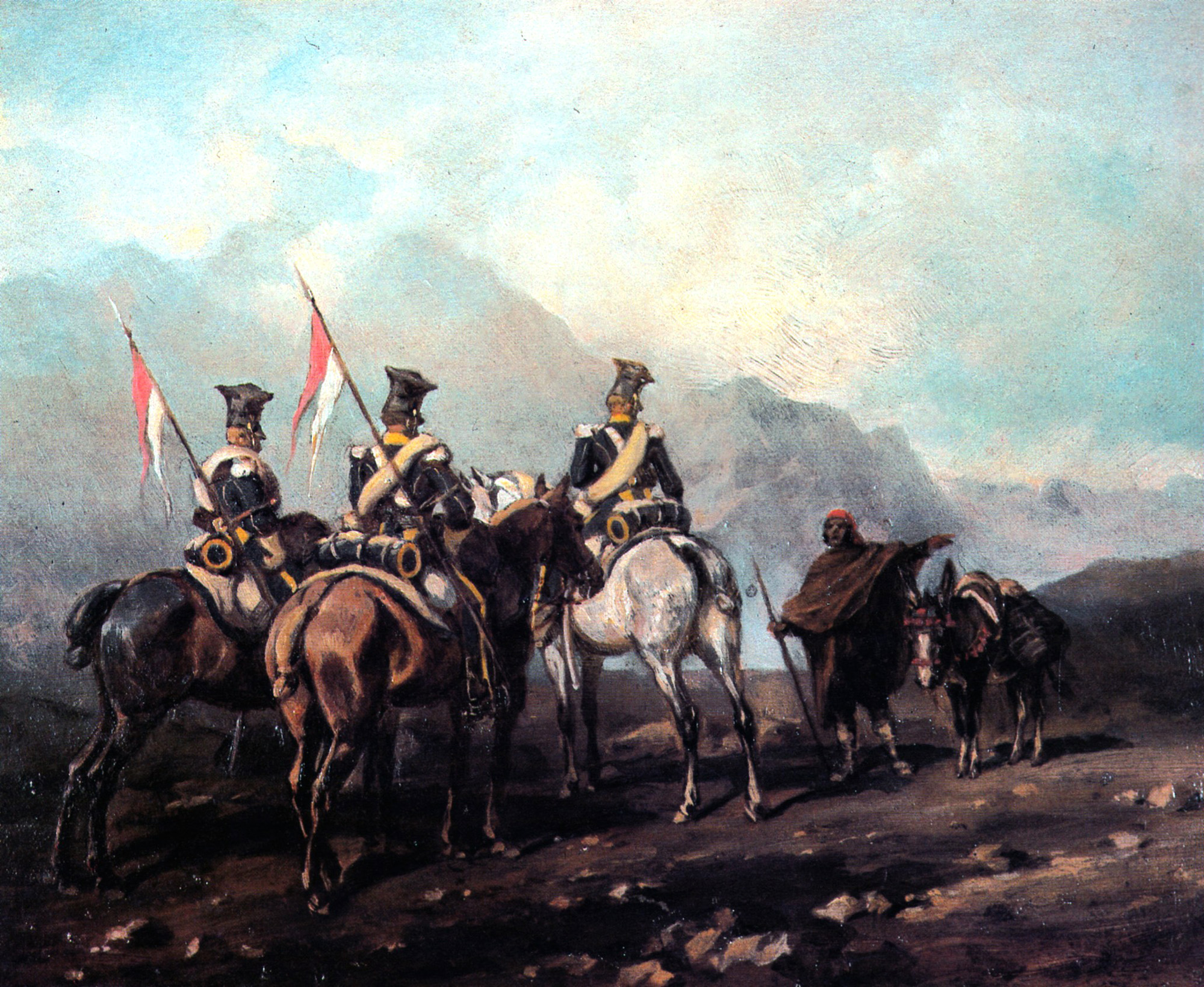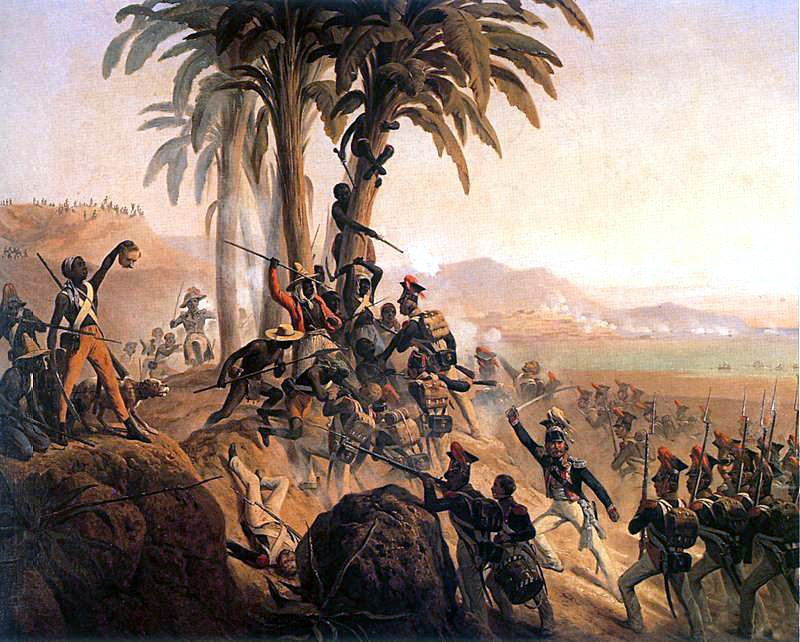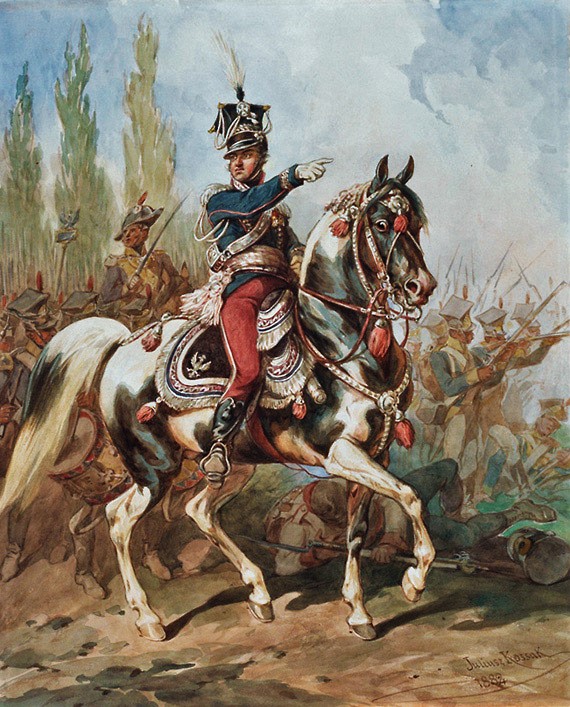|
Legion Of The Vistula
The Legion of the Vistula () was a combined arms legion of the French Imperial Army which served in the Napoleonic Wars. Raised in 1807, the legion served in the Peninsular War, French invasion of Russia and War of the Sixth Coalition before being disbanded in 1814. It was one of the largest Polish Legions of the Napoleonic era. Creation of the Legion The Legion was formed in Breslau, Neustadt, Brieg, Neisse and Friedland, in the region of Silesia in February 1807 from an infantry regiment and cavalry regiment in the service of the Kingdom of Naples that were descended from Jan Henryk Dąbrowski's Dąbrowski's Legions and Karol Kniaziewicz's Danube Legion originally raised in the 1790s. The new formation was expanded from the Neapolitan cadre into a formation of three infantry regiments and one cavalry regiment, initially named the Polish-Italian Legion as it had been organized around the Poles formerly in Italian service. Most of the recruits came from ex-Prussian and ... [...More Info...] [...Related Items...] OR: [Wikipedia] [Google] [Baidu] |
French First Empire
The First French Empire or French Empire (; ), also known as Napoleonic France, was the empire ruled by Napoleon Bonaparte, who established French hegemony over much of continental Europe at the beginning of the 19th century. It lasted from 18 May 1804 to 6 April 1814 and again briefly from 20 March 1815 to 7 July 1815, when Napoleon was exiled to Saint Helena. Although France had already established a colonial empire overseas since the early 17th century, the French state had remained a kingdom under the Bourbons and a republic after the French Revolution. Historians refer to Napoleon's regime as the ''First Empire'' to distinguish it from the restorationist '' Second Empire'' (1852–1870) ruled by his nephew Napoleon III. On 18 May 1804 (28 Floréal year XII on the French Republican calendar), Napoleon was granted the title Emperor of the French (, ) by the French and was crowned on 2 December 1804 (11 Frimaire year XIII), signifying the end of the French Consulate ... [...More Info...] [...Related Items...] OR: [Wikipedia] [Google] [Baidu] |
Brzeg
Brzeg (; Latin: ''Alta Ripa'', German: ''Brieg'', Silesian German: ''Brigg'', , ) is a town in southwestern Poland with 34,778 inhabitants (December 2021) and the capital of Brzeg County. It is situated in Silesia in the Opole Voivodeship on the left bank of the Oder river. The town of Brzeg was first mentioned as a trading and fishing settlement within fragmented Piast-ruled Poland in 1234. In 1248, Silesian Duke Henry III the White granted the settlement Magdeburg town rights and by the late 13th century the city became fortified. Sometimes referred to as "the garden town", the town's size greatly expanded after the construction of dwelling houses which were located on the city outskirts. From the early 14th to late 17th centuries, the town was ruled by the Piast dynasty as fiefs of the Bohemian Crown within the Holy Roman Empire. Later, as the result of the Silesian Wars, the town passed to Prussia, and from 1871 to 1945 it was also part of Germany, before it became agai ... [...More Info...] [...Related Items...] OR: [Wikipedia] [Google] [Baidu] |
Austrian Empire
The Austrian Empire, officially known as the Empire of Austria, was a Multinational state, multinational European Great Powers, great power from 1804 to 1867, created by proclamation out of the Habsburg monarchy, realms of the Habsburgs. During its existence, it was the third most populous monarchy in Europe after the Russian Empire and the United Kingdom of Great Britain and Ireland, United Kingdom, while geographically, it was the third-largest empire in Europe after the Russian Empire and the First French Empire. The empire was proclaimed by Francis II, Holy Roman Emperor, Francis II in 1804 in response to Napoleon's declaration of the First French Empire, unifying all Habsburg monarchy, Habsburg possessions under one central government. It remained part of the Holy Roman Empire until the latter's dissolution in 1806. It continued fighting against Napoleon throughout the Napoleonic Wars, except for a period between 1809 and 1813, when Austria was first allied with Napoleon ... [...More Info...] [...Related Items...] OR: [Wikipedia] [Google] [Baidu] |
Prussia
Prussia (; ; Old Prussian: ''Prūsija'') was a Germans, German state centred on the North European Plain that originated from the 1525 secularization of the Prussia (region), Prussian part of the State of the Teutonic Order. For centuries, the House of Hohenzollern ruled Prussia, expanding its size with the Prussian Army. Prussia, with its capital at Königsberg and then, when it became the Kingdom of Prussia in 1701, History of Berlin, Berlin, decisively shaped the history of Germany. Prussia formed the German Empire when it united the German states in 1871. It was ''de facto'' dissolved by 1932 Prussian coup d'état, an emergency decree transferring powers of the Prussian government to German Chancellor Franz von Papen in 1932 and ''de jure'' by Abolition of Prussia, an Allied decree in 1947. The name ''Prussia'' derives from the Old Prussians who were conquered by the Teutonic Knightsan organized Catholic medieval Military order (religious society), military order of Pru ... [...More Info...] [...Related Items...] OR: [Wikipedia] [Google] [Baidu] |
Cavalry
Historically, cavalry (from the French word ''cavalerie'', itself derived from ''cheval'' meaning "horse") are groups of soldiers or warriors who Horses in warfare, fight mounted on horseback. Until the 20th century, cavalry were the most mobile of the combat arms, operating as light cavalry in the roles of reconnaissance, Screening (tactical), screening, and skirmisher, skirmishing, or as heavy cavalry for decisive economy of force and shock attacks. An individual soldier in the cavalry is known by a number of designations depending on era and tactics, such as a cavalryman, Equestrianism, horseman, trooper (rank), trooper, cataphract, knight, Drabant Corps of Charles XII, drabant, hussar, uhlan, mamluk, cuirassier, lancer, dragoon, samurai or horse archer. The designation of ''cavalry'' was not usually given to any Military animal, military forces that used other animals or platforms for mounts, such as chariots, Camel cavalry, camels or War elephant, elephants. Infantry who m ... [...More Info...] [...Related Items...] OR: [Wikipedia] [Google] [Baidu] |
Regiment
A regiment is a military unit. Its role and size varies markedly, depending on the country, military service, service, or administrative corps, specialisation. In Middle Ages, Medieval Europe, the term "regiment" denoted any large body of line regiment, front-line soldiers, recruited or conscripted in one geographical area, by a leader who was often also the feudal lord ''in capite'' of the soldiers. Lesser barons of knightly rank could be expected to muster or hire a Company (military unit), company or battalion from their manorial estate. By the end of the 17th century, infantry regiments in most European armies were permanent units, with approximately 800 men and commanded by a colonel. Definitions During the modern era, the word "regiment" – much like "corps" – may have two somewhat divergent meanings, which refer to two distinct roles: # a front-line military formation; or # an administrative or ceremonial unit. In many armies, the first role has been assumed by i ... [...More Info...] [...Related Items...] OR: [Wikipedia] [Google] [Baidu] |
Infantry
Infantry, or infantryman are a type of soldier who specialize in ground combat, typically fighting dismounted. Historically the term was used to describe foot soldiers, i.e. those who march and fight on foot. In modern usage, the term broadly encompasses a wide variety of subspecialties, including light infantry, irregular infantry, heavy infantry, mountain infantry, motorized infantry, mechanized infantry, Airborne forces, airborne infantry, Air assault, air assault infantry, and Marines, naval infantry. Other subtypes of infantry, such as line infantry and mounted infantry, were once commonplace but fell out of favor in the 1800s with the invention of more accurate and powerful weapons. Etymology and terminology In English, use of the term ''infantry'' began about the 1570s, describing soldiers who march and fight on foot. The word derives from Middle French , from older Italian (also Spanish) ''infanteria'' (foot soldiers too inexperienced for cavalry), from Latin '' ... [...More Info...] [...Related Items...] OR: [Wikipedia] [Google] [Baidu] |
Danube Legion
The Danube Legion (; ) was a Polish Legion of the French Revolutionary Army which existed from 1799 to 1803. It was renamed as the 3rd Polish Half-Brigade in December 1801 and the 113th Line Infantry Half-Brigade on September 1802, before being amalgamated with the 114th Line Infantry Half-Brigade in 1803. Creation The Danube Legion was raised on 8 September 1799 in the Batavian Republic by Brigadier-General Karol Kniaziewicz. One of the French Revolutionary Army's Polish Legions, its ranks consisted of Polish volunteers and Austrian Army prisoners of war who were ethnic Poles. At its establishment, the unit consisted of four infantry battalions with a theoretical strength of 1,230 men each, an uhlan regiment theoretically 928 men strong and a field artillery company. With a general staff of 15 officers, the Danube Legion was placed under Kniaziewicz's direct command and made available for French military operations. Service in Germany and Italy The Danube Legion was subsequ ... [...More Info...] [...Related Items...] OR: [Wikipedia] [Google] [Baidu] |
Karol Kniaziewicz
Baron Karol Otto Kniaziewicz (4 May 1762 in Assiten, Courland (now Asīte, Latvia) – 9 May 1842 in Paris) was a Polish general and political activist. Karol attended the Knight School in Warsaw. He participated in the Polish-Russian war of 1792 and the Kościuszko Uprising in the rank of a Major-General in 1794. He distinguished himself during the Napoleonic Wars in the Polish Legions as commander of the ''1st Legion''. In 1799 he was appointed to the position of a Brigadier General. From 1799 until 1801 he organized and commanded the " Danube Legion" (''Legia Naddunajska''), he distinguished himself during the Battle of Hohenlinden. Since 1812 Brigadier General in the Duchy of Warsaw. He participated in the Russian Campaign of 1812. In 1814 he left Poland for France. During the November Uprising in 1830–1831 he served as representative of the "Polish National Government" in Paris. In emigration Karol was politically tied with the " Hôtel Lambert" and Adam Jerzy Cza ... [...More Info...] [...Related Items...] OR: [Wikipedia] [Google] [Baidu] |
Polish Legions (Napoleonic Period)
The Polish Legions (; also known as the Dąbrowski Legions) were several Polish military units that served with the French Army in the Napoleonic era, mainly from 1797 to 1803, although some units continued to serve until 1815. After the Third Partition of Poland in 1795, many Poles believed that Revolutionary France and her allies would come to Poland's aid. France's enemies included Poland's partitioners, Prussia, Austria and Russia. Many Polish soldiers, officers, and volunteers therefore emigrated, especially to the parts of Italy under French rule or serving as client states or sister republics to France (leading to the expression, "the Polish Legions in Italy") and to France itself, where they joined forces with the local military. The number of Polish recruits soon reached many thousands. With support from Napoleon Bonaparte, Polish military units were formed, bearing Polish military ranks and commanded by Polish officers. They became known as the "Polish Legions", ... [...More Info...] [...Related Items...] OR: [Wikipedia] [Google] [Baidu] |
Jan Henryk Dąbrowski
Jan Henryk Dąbrowski (; also known as Johann Heinrich Dąbrowski (Dombrowski) in German and Jean Henri Dombrowski in French; 2 August 1755 – 6 June 1818) was a Polish general and statesman, widely respected after his death for his patriotic attitude, and described as a national hero who spent his whole life fighting to restore the legacy and self-determination of Poland. Dąbrowski initially served in the Saxon Army and joined the Polish–Lithuanian Commonwealth Army in 1792, shortly before the Second Partition of Poland. He was promoted to the rank of general in the Kościuszko Uprising of 1794. After the final Third Partition of Poland, which ended the existence of Poland as an independent country, he became actively involved in promoting the cause of Polish independence abroad. He was the founder of the Polish Legions in Italy serving under Napoleon Bonaparte from 1795, and as a general in Italian and French service he contributed to the brief restoration of the P ... [...More Info...] [...Related Items...] OR: [Wikipedia] [Google] [Baidu] |
Kingdom Of Naples
The Kingdom of Naples (; ; ), officially the Kingdom of Sicily, was a state that ruled the part of the Italian Peninsula south of the Papal States between 1282 and 1816. It was established by the War of the Sicilian Vespers (1282–1302). Until then, the island of Sicily and southern Italy had constituted the "Kingdom of Sicily". When the island of Sicily revolted and was conquered by the Crown of Aragon, it become a separate kingdom also called the Kingdom of Sicily. This left the Neapolitan mainland in the possession of Charles of Anjou who continued to use the name "Kingdom of Sicily". Later, two competing lines of the Angevin family competed for the Kingdom of Naples in the late 14th century, which resulted in the murder of Joanna I at the hands of her successor, Charles III of Naples. Charles' daughter Joanna II adopted King Alfonso V of Aragon as heir, who would then unite Naples into his Aragonese dominions in 1442. As part of the Italian Wars, France briefly r ... [...More Info...] [...Related Items...] OR: [Wikipedia] [Google] [Baidu] |




